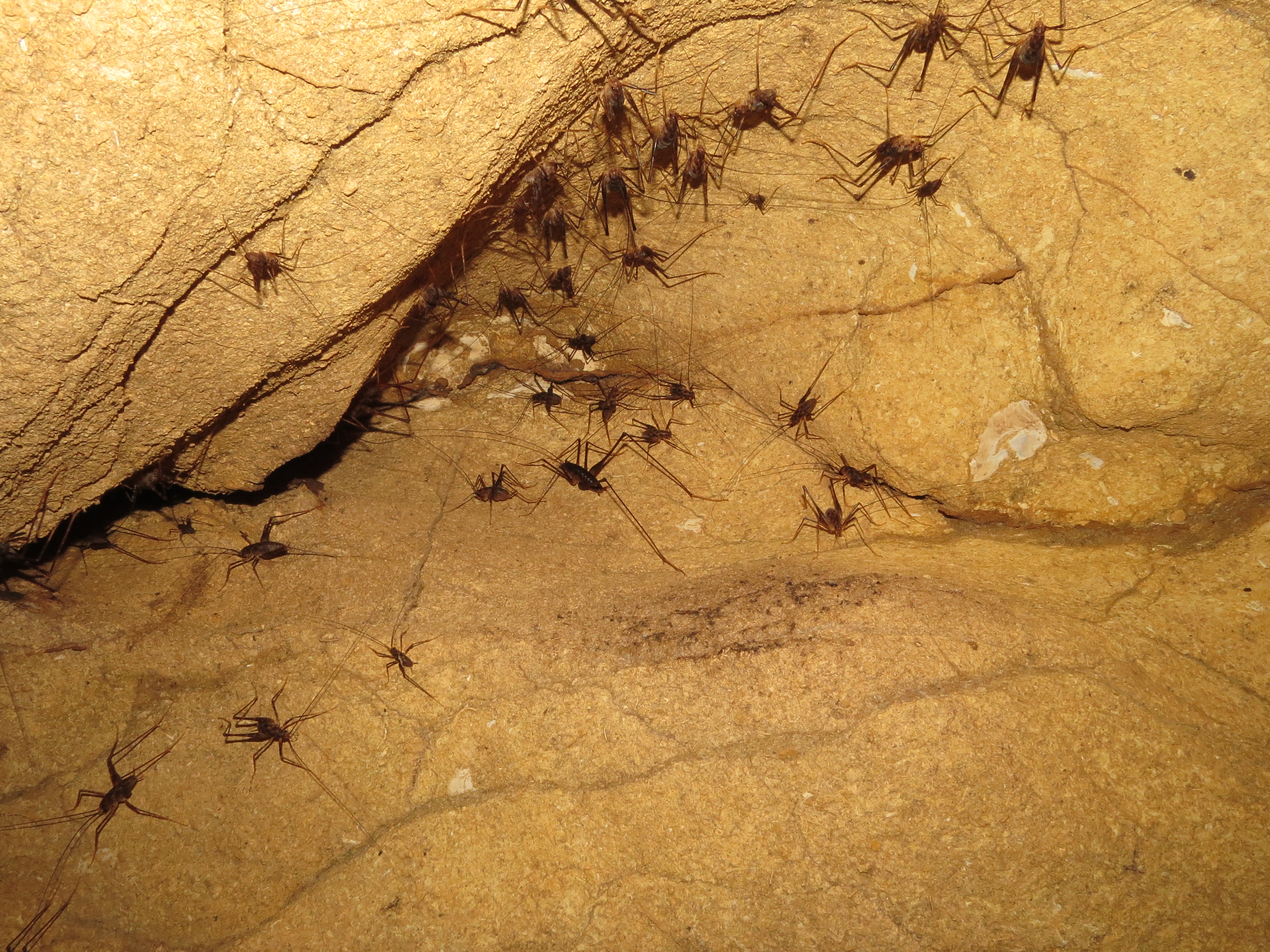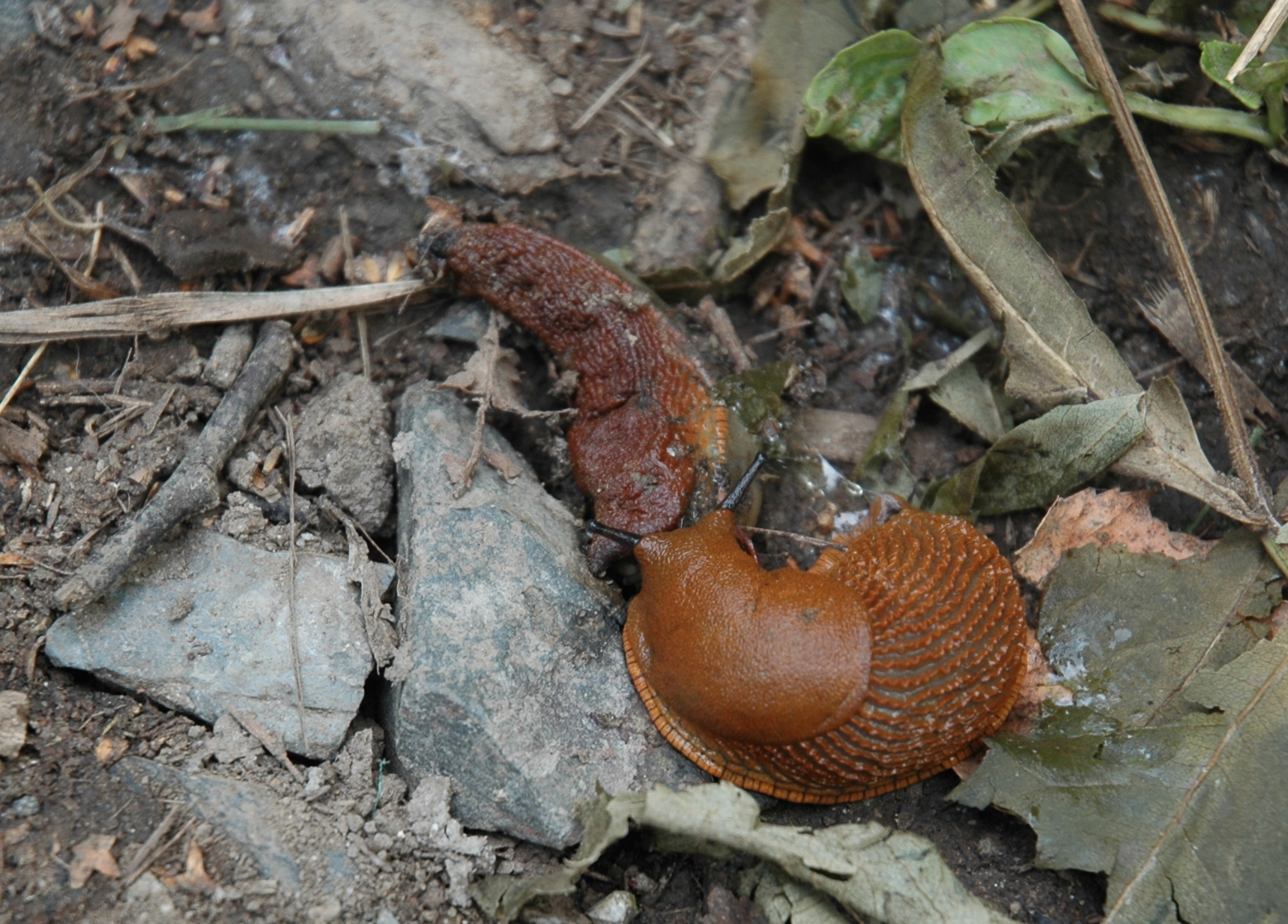|
Pachyrhamma Edwardsii
''Pachyrhamma edwardsii'' is a species of wētā, in the family Rhaphidophoridae (cave crickets, cave wētā, or camel crickets), endemic to New Zealand. This species is found in caves, or large cavities (cave-like structures) where there is high humidity and little plant or animal life. Habitats and distribution ''Pachyrhamma edwardsii'' is widespread in central New Zealand from Waikato, North Island to Nelson, South Island. It is a common occupant of anthropogenic rock tunnels and limestone caves and is found in forests and stony stream beds. It also inhabits offshore Islands of Marlborough sounds, and Mana and Kapiti Islands near Wellington. This species can be found at night in forests, and near cave entrances. They belong to a moisture-loving group of insects, and prefer cool temperatures, and high humidity. Morphology Small bodies up to about 41mm (Average 35mm) length. Very long hind legs (leg: body ratio = 3.17:1), antennae (4.5-5 x body length), and ovi ... [...More Info...] [...Related Items...] OR: [Wikipedia] [Google] [Baidu] |
Samuel Hubbard Scudder
Samuel Hubbard Scudder (April 13, 1837 – May 17, 1911) was an American entomologist and paleontologist. He was a leading figure in entomology during his lifetime and the founder of insect paleontology in America. In addition to fossil insects, he was an authority on butterflies ( Lepidoptera) and grasshoppers (Orthoptera). Biography Scudder was born on April 13, 1837, in Boston, Massachusetts, the son of Charles Scudder and Sarah Lathrop (Coit) Scudder. His father was a successful merchant, and both parents had Puritan roots dating back to the founding of the Massachusetts Bay Colony in the 1620s. He was raised in a strict Calvinist Congregational household.Leach (2013) One of his younger brothers, Horace Scudder, became a noted author and editor of the ''Atlantic Monthly'',Cockerell (1911) while his niece Vida Dutton Scudder was a writer and social activist. Scudder attended Boston Latin School, and then enrolled in Williams College in 1853 at the age of 16. He studied with ... [...More Info...] [...Related Items...] OR: [Wikipedia] [Google] [Baidu] |
Kapiti Island
Kapiti Island () is an island about off the west coast of the lower North Island of New Zealand. It is long, running southwest/northeast, and roughly wide, being more or less rectangular in shape, and has an area of . Its name has been used since 1989 by the Kapiti Coast District Council, which includes towns such as Paekakariki, Raumati South, Paraparaumu and Waikanae. The island is separated from the North Island by the Rauoterangi Channel. The highest point on the island is Tūteremoana, . The seaward (west) side of the island is particularly rocky and has high cliffs, some hundreds of metres high, that drop straight into the sea. The cliffs are subject to very strong prevailing westerly winds and the scrubby vegetation that grows there is low and stunted by the harsh environmental conditions. A cross-section of the island would show almost a right-angled triangle, revealing its origins from lying on a fault line (part of the same ridge as the Tararua Range). The isla ... [...More Info...] [...Related Items...] OR: [Wikipedia] [Google] [Baidu] |
Gestation
Gestation is the period of development during the carrying of an embryo, and later fetus, inside viviparous animals (the embryo develops within the parent). It is typical for mammals, but also occurs for some non-mammals. Mammals during pregnancy can have one or more gestations at the same time, for example in a multiple birth. The time interval of a gestation is called the ''gestation period''. In obstetrics, '' gestational age'' refers to the time since the onset of the last menses, which on average is fertilization age plus two weeks. Mammals In mammals, pregnancy begins when a zygote (fertilized ovum) implants in the female's uterus and ends once the fetus leaves the uterus during labor or an abortion (whether induced or spontaneous). Humans In humans, pregnancy can be defined clinically or biochemically. Clinically, pregnancy starts from first day of the mother's last period. Biochemically, pregnancy starts when a woman's human chorionic gonadotropin (hCG) le ... [...More Info...] [...Related Items...] OR: [Wikipedia] [Google] [Baidu] |
Ovipositor
The ovipositor is a tube-like organ used by some animals, especially insects, for the laying of eggs. In insects, an ovipositor consists of a maximum of three pairs of appendages. The details and morphology of the ovipositor vary, but typically its form is adapted to functions such as preparing a place for the egg, transmitting the egg, and then placing it properly. For most insects, the organ is used merely to attach the egg to some surface, but for many parasitic species (primarily in wasps and other Hymenoptera), it is a piercing organ as well. Some ovipositors only retract partly when not in use, and the basal part that sticks out is known as the scape, or more specifically oviscape, the word ''scape'' deriving from the Latin word '' scāpus'', meaning "stalk" or "shaft". In insects Grasshoppers use their ovipositors to force a burrow into the earth to receive the eggs. Cicadas pierce the wood of twigs with their ovipositors to insert the eggs. Sawflies slit t ... [...More Info...] [...Related Items...] OR: [Wikipedia] [Google] [Baidu] |
Copulation (zoology)
In zoology, copulation is animal sexual behavior in which a male introduces sperm into the female's body, especially directly into her reproductive tract. This is an aspect of mating. Many animals that live in water use external fertilization, whereas internal fertilization may have developed from a need to maintain gametes in a liquid medium in the Late Ordovician epoch. Internal fertilization with many vertebrates (such as all reptiles, some fish, and most birds) occurs via cloacal copulation, known as cloacal kiss (see also hemipenis), while mammals copulate vaginally, and many basal vertebrates reproduce sexually with external fertilization. In spiders and insects Spiders are often confused with insects, but they are not insects; instead, they are arachnids. Spiders have separate male and female sexes. Before mating and copulation, the male spider spins a small web and ejaculates on to it. He then stores the sperm in reservoirs on his large pedipalps, from which he ... [...More Info...] [...Related Items...] OR: [Wikipedia] [Google] [Baidu] |
Pachyrhamma Edwardsii 16177573
''Pachyrhamma'' is a genus of cave weta (New Zealand cave cricket, ''tokoriro'') in the family Rhaphidophoridae, endemic to New Zealand. Cook et al. (2010) found that ''Gymnoplectron'' and ''Turbottoplectron'' are synonymised with ''Pachyrhamma''. They follow W.F. Kirby (1906) and Karny (1937) in treating ''Pachyrhamma'' as a neuter noun. Ecology Members of the genus are detritivorous scavengers that inhabit dark, damp refugia such as hollow logs, overhangs and caves during the day. They become more active at night and venture into the surrounding undergrowth to forage. They consume various organic matter such as plant seeds, fungi, animal droppings, and dead animal tissue. They will cannibalise the remains of other dead weta, and may also attack still-living cave weta while they are vulnerable during ecdysis (shedding their exoskeleton). Species When ''Pachyrhamma'' is treated as a neuter noun, species names have a neuter suffix, e.g. ''-ceras'' rather than ''-cera'', an ... [...More Info...] [...Related Items...] OR: [Wikipedia] [Google] [Baidu] |
Ecdysis
Ecdysis is the moulting of the cuticle in many invertebrates of the clade Ecdysozoa. Since the cuticle of these animals typically forms a largely inelastic exoskeleton, it is shed during growth and a new, larger covering is formed. The remnants of the old, empty exoskeleton are called exuviae. After moulting, an arthropod is described as ''teneral'', a ''callow''; it is "fresh", pale and soft-bodied. Within one or two hours, the cuticle hardens and darkens following a tanning process analogous to the production of leather. During this short phase the animal expands, since growth is otherwise constrained by the rigidity of the exoskeleton. Growth of the limbs and other parts normally covered by the hard exoskeleton is achieved by transfer of body fluids from soft parts before the new skin hardens. A spider with a small abdomen may be undernourished but more probably has recently undergone ecdysis. Some arthropods, especially large insects with tracheal respiration, expand thei ... [...More Info...] [...Related Items...] OR: [Wikipedia] [Google] [Baidu] |
Cannibalism
Cannibalism is the act of consuming another individual of the same species as food. Cannibalism is a common ecological interaction in the animal kingdom and has been recorded in more than 1,500 species. Human cannibalism is well documented, both in ancient and in recent times. The rate of cannibalism increases in nutritionally poor environments as individuals turn to members of their own species as an additional food source.Elgar, M.A. & Crespi, B.J. (1992) ''Cannibalism: ecology and evolution among diverse taxa'', Oxford University Press, Oxford ngland New York. Cannibalism regulates population numbers, whereby resources such as food, shelter and territory become more readily available with the decrease of potential competition. Although it may benefit the individual, it has been shown that the presence of cannibalism decreases the expected survival rate of the whole population and increases the risk of consuming a relative. Other negative effects may include the increased r ... [...More Info...] [...Related Items...] OR: [Wikipedia] [Google] [Baidu] |
Lichen
A lichen ( , ) is a composite organism that arises from algae or cyanobacteria living among filaments of multiple fungi species in a mutualistic relationship.Introduction to Lichens – An Alliance between Kingdoms . University of California Museum of Paleontology. Lichens have properties different from those of their component organisms. They come in many colors, sizes, and forms and are sometimes plant-like, but are not plants. They may have tiny, leafless branches ( fruticose); flat leaf-like structures ( foliose); grow crust ... [...More Info...] [...Related Items...] OR: [Wikipedia] [Google] [Baidu] |
Fungus
A fungus (plural, : fungi or funguses) is any member of the group of Eukaryote, eukaryotic organisms that includes microorganisms such as yeasts and Mold (fungus), molds, as well as the more familiar mushrooms. These organisms are classified as a Kingdom (biology), kingdom, separately from the other eukaryotic kingdoms, which by one traditional classification include Plantae, Animalia, Protozoa, and Chromista. A characteristic that places fungi in a different kingdom from plants, bacteria, and some protists is chitin in their cell walls. Fungi, like animals, are heterotrophs; they acquire their food by absorbing dissolved molecules, typically by secreting digestive enzymes into their environment. Fungi do not photosynthesize. Growth is their means of motility, mobility, except for spores (a few of which are flagellated), which may travel through the air or water. Fungi are the principal decomposers in ecological systems. These and other differences place fungi in a single gro ... [...More Info...] [...Related Items...] OR: [Wikipedia] [Google] [Baidu] |
Nocturnality
Nocturnality is an animal behavior characterized by being active during the night and sleeping during the day. The common adjective is "nocturnal", versus diurnal meaning the opposite. Nocturnal creatures generally have highly developed senses of hearing, smell, and specially adapted eyesight. Some animals, such as cats and ferrets, have eyes that can adapt to both low-level and bright day levels of illumination (see metaturnal). Others, such as bushbabies and (some) bats, can function only at night. Many nocturnal creatures including tarsiers and some owls have large eyes in comparison with their body size to compensate for the lower light levels at night. More specifically, they have been found to have a larger cornea relative to their eye size than diurnal creatures to increase their : in the low-light conditions. Nocturnality helps wasps, such as ''Apoica flavissima'', avoid hunting in intense sunlight. Diurnal animals, including squirrels and songbirds, are act ... [...More Info...] [...Related Items...] OR: [Wikipedia] [Google] [Baidu] |
Insect
Insects (from Latin ') are pancrustacean hexapod invertebrates of the class Insecta. They are the largest group within the arthropod phylum. Insects have a chitinous exoskeleton, a three-part body (head, thorax and abdomen), three pairs of jointed legs, compound eyes and one pair of antennae. Their blood is not totally contained in vessels; some circulates in an open cavity known as the haemocoel. Insects are the most diverse group of animals; they include more than a million described species and represent more than half of all known living organisms. The total number of extant species is estimated at between six and ten million; In: potentially over 90% of the animal life forms on Earth are insects. Insects may be found in nearly all environments, although only a small number of species reside in the oceans, which are dominated by another arthropod group, crustaceans, which recent research has indicated insects are nested within. Nearly all insects hatch from eggs ... [...More Info...] [...Related Items...] OR: [Wikipedia] [Google] [Baidu] |











